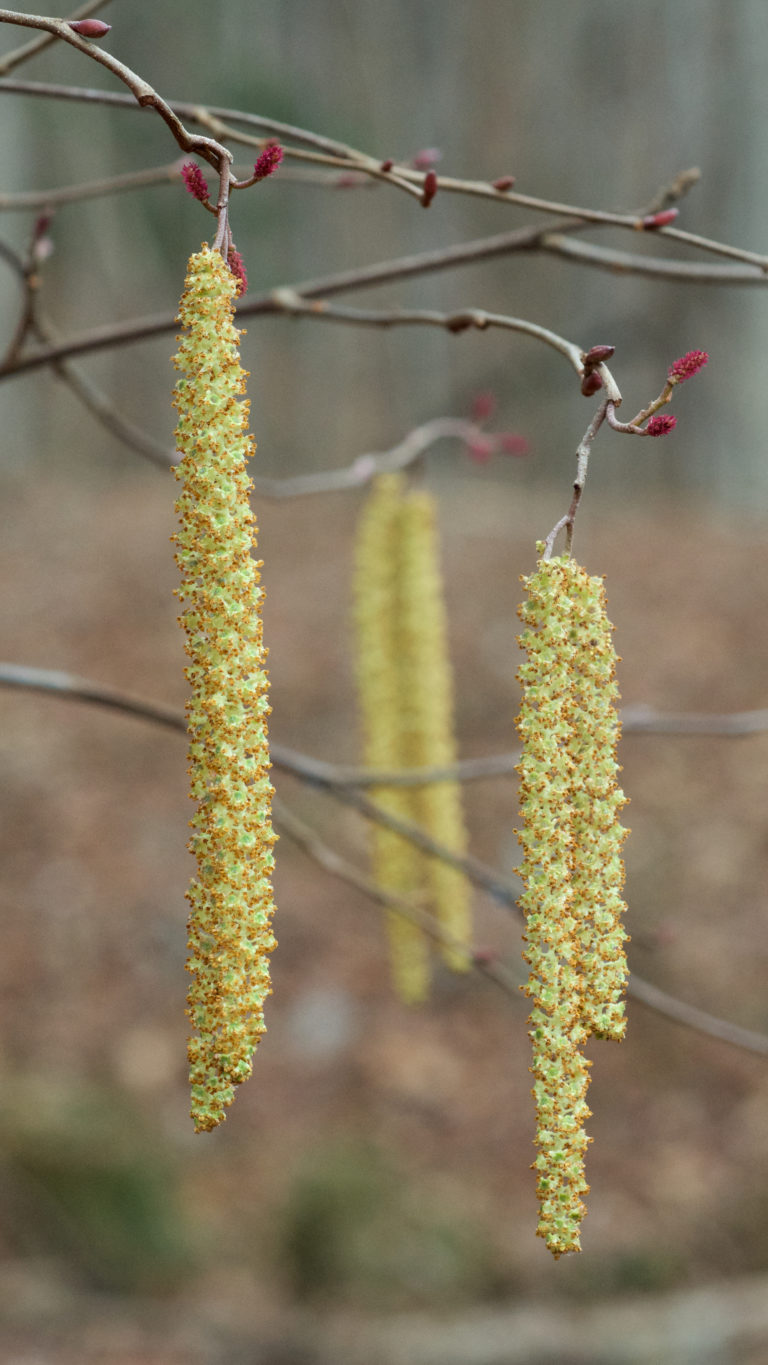Tag Alder is a multi-stemmed, deciduous shrub or small tree found on stream banks and in wet meadows in Eastern North America (Main to Florida; as far west as Oklahoma, Missouri and Illinois). Leaves are alternate, elliptical, with serrated margins, deep green turning to yellow tinged with red in the fall. Alder is recognized by its unusual, drooping, yellowish male catkins and red female flower structures in spring and small, woody cones in fall. With its fibrous, shallow root system, Alder is a great choice for stream bank stabilization. Its water use is high, and it fixes its own atmospheric nitrogen, naturally forming thickets along watercourses. However, it also thrives in well drained upland soil where it is often used to improve wildlife habitat. Seeds are eaten by a variety of bird species (Woodcocks, Ruffed grouse), small mammals and rodents. Alders also serve as host plants for beetles, moth and butterfly caterpillars and other insects. Deer browse the leaves and bark. And finally, dense branching habit provides cover and nesting habitat for the American Woodcock, Rusty Grackle, and other birds. It is considered a critical cover component for Woodcock habitat and is an excellent choice for general enrichment of food and cover resources for our native fauna.
NURSERY HOURS
Wednesday: 10-4 Thursday: 10-6 Friday-Saturday: 10-4 Sunday: 12-4
Alnus serrulata

Key Info
Scientific Name: Alnus serrulata (Aiton) Willd.
Common Names: Hazel or Smooth Alder, Tag Alder, Hazel alder, Brookside Alder, Common Alder, Black Alder
Family Names: Betulaceae (Birch Family)
Plant Type: Tree / Shrub
Leaf Retention: Deciduous
Flower Color: Yellowish brown (male) and purple/red (female)
Additional Info
Habit: A large multi-stemmed, suckering shrub or small tree with rounded form, fibrous root system and smooth grey bark; forms thickets along watercourses.
Height: 10-15'
Spread: 8-10'
Soil Conditions: Average to wet; prefers moist but can tolerate drought; pH circumneutral (5.5-7.5); clay, loamy.
Leaves: Alternate, simple, elliptical, serrated margins and pinnate, conspicuous venation; deep green, turning to yellow tinged with red in the fall; fall color not considered conspicuous
Flowers (or reproductive structures: Catkins: male (larger, greenish, pendulous) and female (smaller, red, upright); male and female flowers on the same plant (monoecious).
Fruit: Small (1/2 inch), persistent woody cones; at the base of each scale is a single nutlet; matures in fall, perisists into winter.
Natural Distribution: Stream banks, wet meadows astern North America (Main to Florida; as far west as Oklahoma, Missouri and Illinois
USDA Hardiness Zone: 5-9
USDA Wetland Indicator Status in NC: FACW+ on Coastal plain, OBL in Piedmont
Pollination: Cross-pollinated by wind.
Wildlife Connections: Seeds are eaten by birds (Woodcocks, Ruffed Grouse), small mammals and rodents; Alders serve as host plants for beetles, aphids, moth and butterfly caterpillars; dense branching habit provides cover and nesting habitat for the American Woodcock, Rusty Grackle, and other birds; deer browse the leaves and bark (Illinoiswildflowers.info).
Propagation: By seed.
